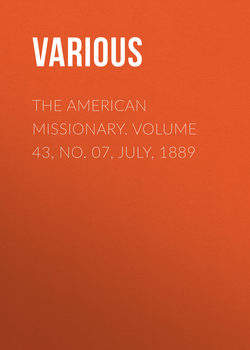Читать книгу The American Missionary. Volume 43, No. 07, July, 1889 - Various - Страница 3
EDITORIAL
CONGREGATIONALISM IN GEORGIA
ОглавлениеAt the recent meeting of the American Home Missionary Society, held in Saratoga (June 6th), the question of the future relations of the newly formed Congregational Conference of Georgia to that Society, and to the earlier Congregational Association of that State, was fully discussed, and resulted in the following action:
In the full conviction that these churches are in accord with the principles of Congregationalism, and with the principles of this Society, and with those held by the Congregational churches which it represents:
Resolved. That we heartily welcome them to fellowship with us in the Gospel. We commend them to the fraternal sympathy and prayers of all our people, and we request the officers of the society to extend to them such financial aid as they may need as promptly as the state of its treasury will allow.
Resolved. That this Society rejoices to learn that an effort is making to unite the Georgia Congregational Conference and the Georgia Congregational Association on principles of equal recognition and fellowship of all the churches of each body, and trust that such a union will be accomplished.
We are in full and hearty agreement with the general spirit of these utterances. In the hope that the churches of the Georgia Conference are in accord with the principles of Congregationalism, which do not discriminate against men because of caste or color, we are prepared to welcome them heartily. That Conference has already published its Articles of Faith and of Church Government, and these have assured us of its adherence to the general principles of the Congregational faith and order. The only question still open is as to the readiness of that body to unite with the Congregational churches already existing in that State in the practical recognition of the broad Christian and Congregational principles in the fellowship of all churches irrespective of caste distinctions.
The second resolution quoted above rejoices in the effort now making to unite the two Congregational bodies in Georgia on that basis. We trust that effort may be successful, for we believe that such a union is essential to recognition by the National Council and to the cordial fellowship of the Congregational churches. The Georgia Association, ever since its organization in 1878, has been recognized and represented in every subsequent meeting of the National Council, and we cannot see how the Council can consistently welcome another organization, covering the same State, that is kept separate from the older body by the line of race or color; nor do we believe that the Congregational churches of this country will fellowship both organizations thus held apart. We are confirmed in the correctness of this impression from the decided and independent utterances of the influential religious papers which so largely represent the sentiments of the Congregational churches of this country.
We present below some extracts from such of these papers published since the Saratoga meeting as have come to hand before the MISSIONARY goes to press, while in another portion of our pages we give more at length the prior utterances of these journals on the same general subject. We deem the question to be so important that we wish to lay it fully before our readers.
From The Independent
We have nothing but satisfaction to express with this action. It would be absurd to imagine that Congregationalists could forget their spotless record, and could now, for the pride of the addition of fifty or a hundred churches, consent to help a movement that should put colored brothers in a separate fellowship by themselves. This they will never do. They will hold out a warm hand of welcome to all comers, and warmest to those who come to them from the South, white and black: but they want them to come together, not apart.
From The Congregationalist
This, we are confident, was the proper attitude for the Society to assume. No one wanted to grieve or irritate the Southern brethren, by clauses in the resolutions, which might seem uncalled for, or at all distrustful of their explicit utterances. At the same time it should be distinctly understood that the unanimous action taken means that the Congregational churches stand exactly where the Presbyterians do, in not abating one hair of their principles, and in forever demanding that color shall prove no barrier to Christian fellowship in its truest, deepest intent. This journal has taken this position repeatedly, and it re-asserts it. Sooner or later, but as surely as the sun-rise, it will prevail, because it is right, and our grandchildren, if not our children, will wonder that any of our generation ever hesitated about it.
From The Advance
Then, the question as to the color-line in the churches, as known to exist in the South, could not be ignored. Our Congregational churches and their two great Home Missionary Societies, the American Home Missionary Society and the American Missionary Association, hold to certain principles respecting the universal brotherhood of believers in Christ, and for which they stand before the world as witnesses, historically, conspicuously, always and everywhere. Do these newly constituted Congregational churches in the South stand with us on this point? To ask this question implies not the slightest suspicion or distrust. Not to have asked it would have been to betray a great responsibility.
For one thing, the Home Missionary Society could not afford to even seem to be indifferent to a matter of this kind. And if there is to be this close fellowship and co-operation and mutual assistance, there should obviously be, from the beginning, the most perfect frankness. The best way to insure permanence of happy mutual relations is to begin right.
